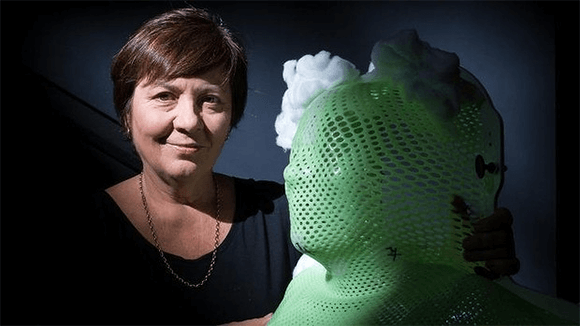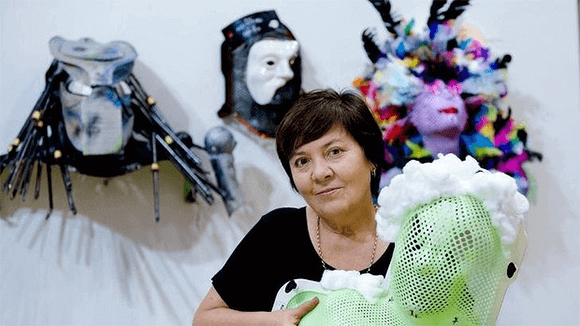
The masks are made of thermoplastic material, moulded to the face and then bolted to the treatment table during lifesaving radiation therapy for head and neck cancers.
Once a day for one month, the former ABC broadcaster Julie McCrossin was tightened in, her head held rigid for 20 minutes, while a powerful precision x-ray zapped the cancer eating away at her tonsils, tongue and throat. She struggled to subdue the rising panic. Every excruciating minute of it.
”My cancer team saved my life and were very caring, but wearing the mask was the most traumatic experience of my life,” McCrossin said.

“It was essential for safety, but frightening. After four sessions I asked for helped. They gave me a mild sedation, music and a clinical psychologist. The clinical psychologist said if I had frightening thoughts in the mask — because I was anxious and having palpitations — to think of them as fluffy white clouds and simply blow them away. It worked.”
McCrossin has taken her green mesh mask — discarded three years ago when she was declared to be in remission — and dressed it with cotton ball clouds for a forthcoming exhibition at the Casula Powerhouse Museum.
Former patients such as McCrossin have been encouraged to take the object of their stress — and recovery — and turn it into a message of positive healing and transformation.
Using the immobilisation masks as art therapy is an idea that has gained momentum ever since a Nashville medical centre in 2009 asked local artists to decorate them and sold them off to raise money for cancer patients.
The idea has been embraced by the Cancer Therapy Centres at Liverpool and Campbelltown hospitals.
Their Wellness program manager Jan Heslep has been running workshops for former patients before the exhibition launch on June 10. One patient is covering the mask in crotchet squares, another has transformed it into a kind of insect predator.
”When you get a cancer diagnosis it causes you to transform you life, your thoughts on the length of your life, or the importance of things in life. This is a concrete way for patients to reflect upon what transformation means to them.”
Dr Dion Forstner, South Western Sydney Cancer Service’s Director of Radiation Oncology, says the mask has triggered claustrophobia in some patients. In one, it brought back long buried childhood memories of being locked in a cupboard; another of a near drowning experience in a boat.
Since the conclusion of her treatment at St Vincent’s Hospital, McCrossin has been advocating for patients with head and neck cancers and has successfully lobbied for more extensive information about the mask to be included in the Cancer Council guide. While health teams are focused on the patient’s survival, more could be done to support patients and ready them for the rigors of treatment.
Hers was an aggressive stage four cancer, caused by the Human Papillomavirus. She was neither a smoker or a drinker, another common cause of neck and head cancers. Radiation and chemotherapy killed the cancer and McCrossin eventually regained her ability to swallow and to talk, though she dropped 20 kilograms over the six- to eight-week treatment.
”It’s a matter of valuing the psychological recovery as well as the physical recovery,” she said. “We can do a lot better nationally for patients and family before, during and after treatment.”
Bravery Unmasked, opens Friday 5.30pm June 10, and runs June, 11-12, 10am-5pm, Casula Powerhouse Arts Centre Performance Space, 1 Powerhouse Rd, Casula.
Originally published: http://www.smh.com.au/entertainment/art-and-design/sydney-arts/cancer-surivivors-turn-treatment-masks-into-art-at-casula-powerhouse-20160527-gom1qt.html
Photos by Edwina Pickles.